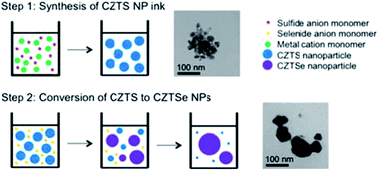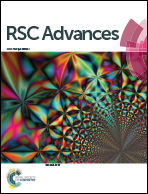Synthesis of large CZTSe nanoparticles through a two-step hot-injection method†
Abstract
Grain boundaries in Cu2ZnSn(SxSe1−x)4 (CZTSSe) thin films act as a defect that reduces the mobility of the charges. Hence one way to improve the performance of these thin film solar cells is to increase the grain size in the films. Most of the synthesis methods published so far for CZTSSe colloidal nanoparticles can achieve a general size distribution range from 5–20 nm. This is where the particle size will saturate for most recipes used today. The assumption is that uniform size distribution is good for grain growth in a thin film but based on packing considerations, an optimal mixture of large and small nanoparticles that can easily be dispersed in non-polar solvents could be better. Cu2ZnSnS4 (CZTS) and Cu2ZnSnSe4 (CZTSe) nanoparticles are synthesized using the hot-injection method with oleylamine, trioctylphosphine, and hexadecane as the solvents. Selenium (Se) is introduced in the liquid phase to encourage grain growth – liquid selenization. This eliminates the need to anneal the film in a Se-containing atmosphere and allows for a more environmentally friendly process with lower temperatures and shorter annealing times. We show that a good dispersion can be achieved by choosing suitable surfactant molecules, solvents and precursors, and by controlling the initial monomer concentration. Additionally, we show how our new synthesis route can be utilized to achieve targeted ratios of CZTS and CZTSe nanoparticles to be used for mixed-phase CZTSSe thin films.


 Please wait while we load your content...
Please wait while we load your content...